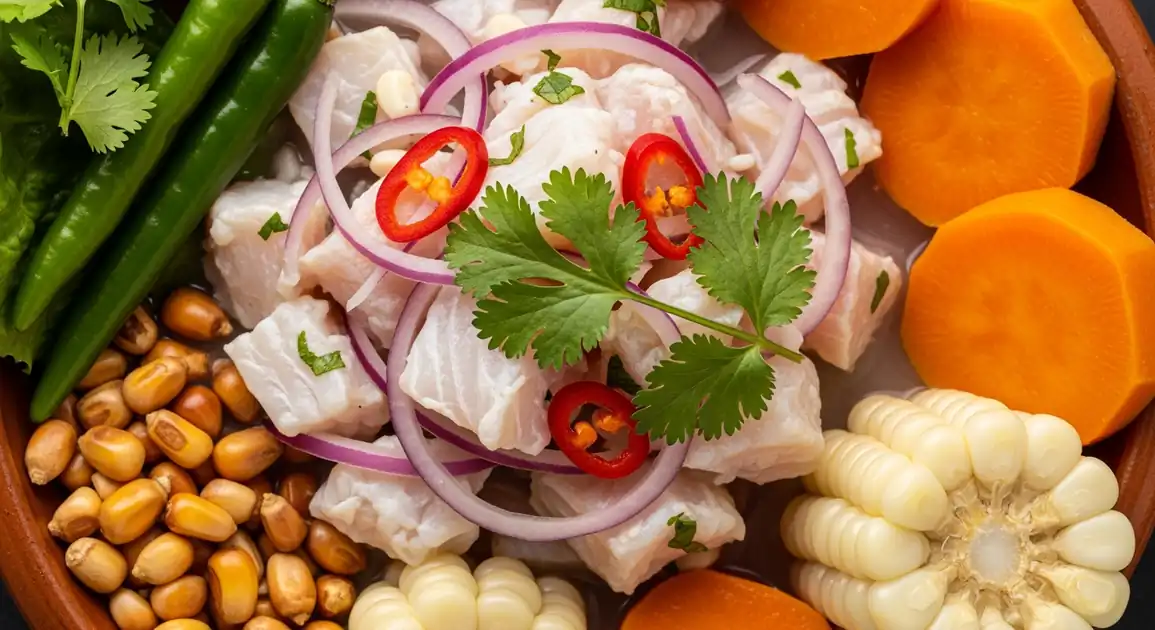Ceviche
Ceviche

Description
Ceviche is Peru's national dish, savored throughout the country but especially celebrated along the coastal regions where freshest seafood is available. While preparation techniques remain relatively consistent nationwide, regional variations reflect local ingredients and flavor preferences. It's considered a lunchtime dish, traditionally eaten during daytime hours when fish is freshest.
Dietary Information
Serving information
Serving style
Traditionally served in a shallow bowl or plate, with the fish and marinade in the center, sweet potato slices and corn kernels arranged alongside. Often garnished with cilantro and sometimes a slice of ají limo (chili pepper).
Quick facts
Most cevicherías operate from 11 AM - 5 PM, with peak hours between 12 PM - 3 PM. Many traditional establishments close by mid-afternoon.
Safety Tips
What to Look For
-
Fresh, clear fish with a sea-like (not fishy) smell
The fish should look vibrant, with clear eyes (if whole), firm flesh, and should smell pleasantly of the sea, not strongly fishy or ammonia-like.
-
Ceviche prepared to order, not pre-marinated
Quality establishments prepare ceviche fresh when ordered, not in large batches sitting in marinade for hours.
-
Busy restaurants with high turnover
Popular places serving numerous customers ensure ingredients are used quickly and not sitting around.
-
Fish stored on ice or refrigerated
Proper temperature control is essential for raw fish safety. Look for fish displayed on ice or in refrigerated cases.
-
Cevicherías that close by mid-afternoon
Traditional places that only serve lunch (closing around 3-4 PM) typically follow the Peruvian custom of only serving fish at its freshest.
What to avoid
-
Fishy smell or grayish flesh
Strong fishy odors or discolored flesh indicate poor quality or old fish, increasing food safety risks.
-
Pre-made ceviche sitting at room temperature
Ceviche should be made fresh and kept cold. Avoid buffets or displays where it sits unrefrigerated.
-
Empty restaurants during peak lunch hours
A lack of customers during prime ceviche hours (11 AM - 3 PM) may indicate locals avoid it for quality reasons.
-
Ceviche served very late at night
Unless it's a high-end restaurant with proper refrigeration and supply chain, very late night ceviche may use fish that's no longer at peak freshness.
-
Cross-contamination risk behaviors
Watch out for vendors handling money and raw fish without washing hands or changing gloves, or using the same cutting surfaces for different ingredients.
Price information
Price range
Budget tips
- Market cevicherías offer quality dishes at 15-25 PEN.
- Set lunch menus ('menú' or 'almuerzo') often include ceviche at reasonable prices (20-30 PEN).
- Street food ceviche may be cheapest (10-15 PEN) but carries higher safety risks.
- Prices typically double or triple in tourist areas and high-end restaurants (up to 70 PEN).
Value indicators
- Fish cut uniformly and looks fresh.
- Served with traditional accompaniments (sweet potato, corn, cancha).
- Marinade is clear and vibrant, not cloudy.
- Preparation happens upon ordering.
- Generous portion size relative to price.
Where to Find This Dish
Coastal Cities
Any coastal Peruvian city will have excellent cevicherías, with the freshest catches.
Fish markets, Waterfront promenades
Late Morning, Lunch
Local Markets
Fresh food markets often have small food stalls serving ceviche.
Fish sections of markets, Food court areas
Morning, Early Afternoon
Tourist Areas
Adapted for international palates, but generally maintain authentic preparation.
Pedestrian zones, Main plazas
Lunch, Afternoon
Vendor Tips
- Ask for fish recommendations - vendors often know what's freshest that day.
- Observing fish preparation area cleanliness is crucial for safety.
- Some vendors offer different spice levels - request 'poco picante' for mild.
How to Order
Regional Variations
-
Ceviche Clásico
(Ceviche Clásico)
The traditional preparation with white fish (typically sea bass/corvina), marinated in lime juice with red onions, chili peppers, and cilantro, served with sweet potato and corn.
-
Ceviche Mixto
(Ceviche Mixto)
Mixed seafood ceviche combining fish with various shellfish like octopus, shrimp, squid, and sometimes scallops.
-
Tiradito
(Tiradito)
A Peruvian-Japanese fusion dish similar to ceviche but with fish cut in sashimi-style slices and without onions. The sauce is usually spread on top rather than marinated.
-
Ceviche de Conchas Negras
(Ceviche de Conchas Negras)
Made with black clams from Peru's northern coast, giving it a distinctive dark color.
-
Ceviche Nikkei
(Ceviche Nikkei)
Japanese-influenced version that might include ingredients like soy sauce, sesame oil, or nori, reflecting Peru's significant Japanese cultural influence.
-
Vegetarian Ceviche
(Ceviche Vegetariano)
Using vegetables like mushrooms, artichoke hearts, or hearts of palm instead of fish, but maintaining the traditional lime marinade and seasonings.
Cultural context
History
Ceviche has ancient origins in Peru, with evidence suggesting similar dishes existed in coastal civilizations over 2,000 years ago. The Moche civilization used fermented juice from local banana passionfruit to marinate fish. After the Spanish conquest, citrus fruits were introduced, evolving the dish to its current lime-based form. In 2004, Peru officially declared ceviche part of its national heritage. Today, while found throughout Latin America, Peruvian ceviche remains distinctive for its brief marination time, resulting in fish that's 'cooked' on the outside but maintains a sashimi-like center, and its specific accompaniments of sweet potato and corn.
Local significance
Ceviche is Peru's national dish and a source of cultural pride. It represents the country's rich maritime resources and culinary innovation. June 28th is celebrated as National Ceviche Day in Peru.
Eating customs
- Mix everything together before eating to incorporate the marinade.
- It's acceptable to drink the remaining leche de tigre directly from the plate or from a small glass if served separately.
- Typically eaten with a fork, though cancha (toasted corn) may be eaten with fingers.
- Often paired with cold beer or chicha morada (purple corn beverage).